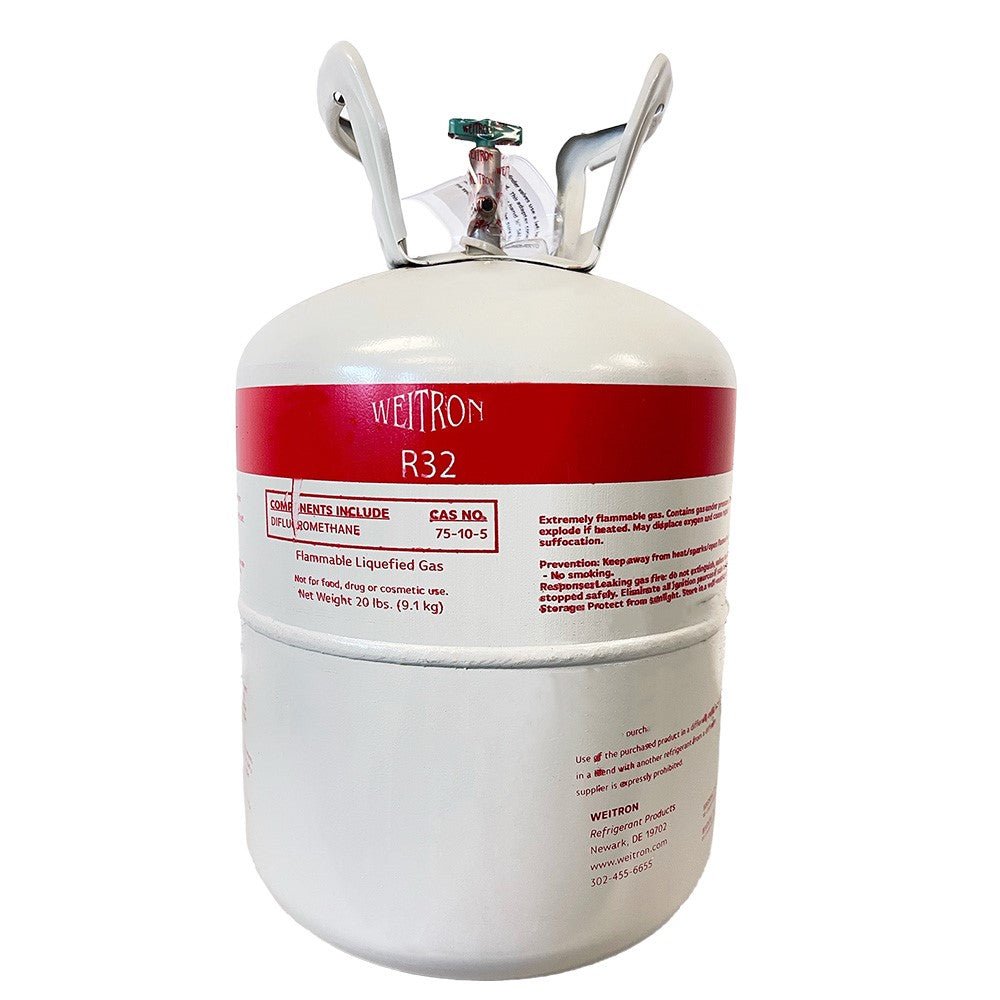Refrigerants play a crucial role in the HVAC industry, and with growing environmental concerns, newer options like R32 are gaining popularity. This blog explores the characteristics, uses, and considerations surrounding R32 refrigerant, including its legality, efficiency, and compatibility with other refrigerants like R410A.
What is R32 Refrigerant?
R32, or difluoromethane, is a hydrofluorocarbon (HFC) refrigerant commonly used in air conditioning and refrigeration systems. It is known for its lower global warming potential (GWP) compared to older refrigerants, making it a more environmentally friendly option.
Characteristics of R32
- Chemical Formula: CH2F2
- GWP: 675, which is significantly lower than R410A's GWP of 2,088.
- Ozone Depletion Potential (ODP): 0, indicating it does not contribute to ozone layer depletion.
- Flammability: R32 is classified as an A2L refrigerant, meaning it has low toxicity but is mildly flammable.
Is R32 Freon Legal in the US?
Yes, R32 is legal for use in the United States. It is increasingly being adopted as an alternative to higher-GWP refrigerants like R410A, especially in new air conditioning systems. The Environmental Protection Agency (EPA) has approved R32 under the Significant New Alternatives Policy (SNAP) program, recognizing it as a lower-impact option compared to some traditional refrigerants.
Is R32 Refrigerant Better Than R410A?
R32 is often considered a better option than R410A for several reasons:
- Environmental Impact: R32 has a much lower GWP than R410A, making it a more sustainable choice for reducing greenhouse gas emissions.
- Energy Efficiency: R32 systems typically offer higher energy efficiency due to its superior thermodynamic properties, which can result in lower electricity bills.
- Cooling Capacity: R32 can provide higher cooling capacity per unit of volume compared to R410A, which means systems can be more compact and efficient.
Can You Replace R410A with R32?
Replacing R410A with R32 is not a straightforward process due to differences in properties and system requirements. Here are some key points to consider:
- System Compatibility: R32 operates at a higher pressure than R410A, requiring components designed to handle these pressures. Direct replacement without modifying the system is not possible.
- Safety Considerations: Given R32's mild flammability, systems must be designed with safety features to mitigate risks.
- Professional Installation: Switching from R410A to R32 requires a professional assessment and potentially significant modifications to the system.
Things to Know About R32 Refrigerant
- Installation Requirements: Due to its flammability, R32 installations must adhere to safety standards and regulations to ensure safe operation.
- Efficiency Gains: Using R32 can lead to significant energy savings due to its efficient heat transfer properties.
- Environmental Benefits: R32's lower GWP contributes to reduced carbon emissions and aligns with global efforts to combat climate change.
Uses of R32 Refrigerant
R32 is primarily used in residential and commercial air conditioning systems. It is suitable for:
- Split Air Conditioners: R32 is widely used in mini-split systems due to its efficiency and cooling performance.
- Heat Pumps: Many heat pumps utilize R32 to provide both heating and cooling functions efficiently.
- Portable Air Conditioners: Compact systems benefit from R32’s high cooling capacity and efficiency.
What Kind of Refrigerant is R32?
R32 is a single-component HFC refrigerant. Unlike blends such as R410A, R32 does not separate into different components, providing consistent performance and efficiency across various conditions.
R32 Refrigerant Oil Type
R32 refrigerant systems typically use polyolester (POE) oil, which is compatible with the chemical properties of R32. POE oils are known for their excellent lubrication and stability, which is crucial for the smooth operation of HVAC systems using R32.
Replacement for R32 Refrigerant
While R32 is currently considered a leading option due to its low GWP and efficiency, future replacements may focus on even lower-GWP refrigerants or natural alternatives. However, R32 is expected to remain a popular choice for many years due to its favorable balance of environmental and performance characteristics.
Conclusion
R32 refrigerant offers a more sustainable and efficient alternative to traditional refrigerants like R410A. Its lower GWP, high energy efficiency, and widespread adoption make it a compelling choice for modern HVAC systems. However, transitioning to R32 requires careful consideration of system compatibility and safety regulations. Consulting with an HVAC professional is essential to ensure a smooth and efficient transition.



